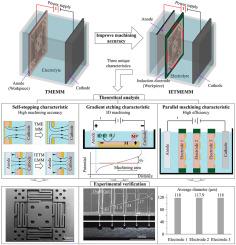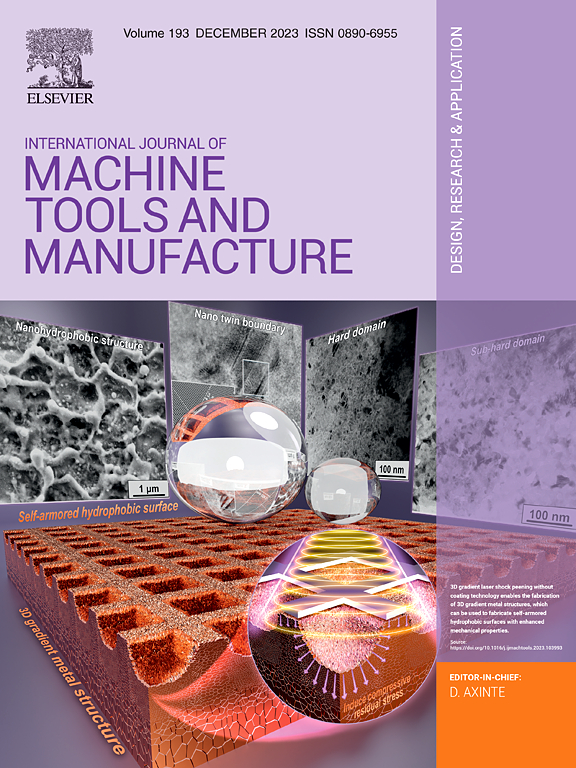A novel method of induction electrode through-mask electrochemical micromachining
IF 18.8
1区 工程技术
Q1 ENGINEERING, MANUFACTURING
International Journal of Machine Tools & Manufacture
Pub Date : 2024-10-13
DOI:10.1016/j.ijmachtools.2024.104221
引用次数: 0
Abstract
Through-mask electrochemical micromachining (TMEMM) is a key method for fabricating metal microstructures. However, the accuracy of TMEMM often falls short of the stringent requirements for many applications, primarily due to the uncontrolled electric field during the machining process. To overcome this limitation, this paper introduces a novel method: induction electrode through-mask electrochemical micromachining (IETMEMM). In this method, two feeder electrodes act as the anode and cathode, generating an electric field where the wireless workpiece is placed. This study explores the principles of electric field control in IETMEMM and develops a simulation model to highlight the method's unique advantages under specific electric field distributions. The findings indicate substantial improvements. Leveraging the self-stopping feature, a MEMS inertial switch was fabricated with high accuracy, achieving a non-uniformity of just 3.8%—a remarkable 96.2 % enhancement in accuracy compared to traditional TMEMM. Additionally, the gradient etching advantage facilitated the creation of both gradient-depth and V-shaped microchannel arrays. Moreover, the parallel machining advantage enabled the simultaneous fabrication of three identical microstructures in just 20 s. These outcomes demonstrate the significant potential of IETMEMM for industrial applications.

感应电极通罩电化学微加工新方法
掩膜电化学微机械加工(TMEMM)是制造金属微结构的一种关键方法。然而,TMEMM 的精度往往达不到许多应用的严格要求,这主要是由于加工过程中电场不受控制。为了克服这一限制,本文介绍了一种新方法:感应电极通过掩模电化学微加工(IETMEMM)。在这种方法中,两个馈电电极充当阳极和阴极,在放置无线工件的地方产生电场。本研究探讨了 IETMEMM 的电场控制原理,并开发了一个仿真模型,以突出该方法在特定电场分布下的独特优势。研究结果表明,该方法有很大改进。利用自停止功能,制造出了高精度的 MEMS 惯性开关,非均匀性仅为 3.8%,与传统的 TMEMM 相比,精度显著提高了 96.2%。此外,梯度蚀刻的优势还有助于创建梯度深度和 V 形微通道阵列。这些成果证明了 IETMEMM 在工业应用方面的巨大潜力。
本文章由计算机程序翻译,如有差异,请以英文原文为准。
求助全文
约1分钟内获得全文
求助全文
来源期刊
CiteScore
25.70
自引率
10.00%
发文量
66
审稿时长
18 days
期刊介绍:
The International Journal of Machine Tools and Manufacture is dedicated to advancing scientific comprehension of the fundamental mechanics involved in processes and machines utilized in the manufacturing of engineering components. While the primary focus is on metals, the journal also explores applications in composites, ceramics, and other structural or functional materials. The coverage includes a diverse range of topics:
- Essential mechanics of processes involving material removal, accretion, and deformation, encompassing solid, semi-solid, or particulate forms.
- Significant scientific advancements in existing or new processes and machines.
- In-depth characterization of workpiece materials (structure/surfaces) through advanced techniques (e.g., SEM, EDS, TEM, EBSD, AES, Raman spectroscopy) to unveil new phenomenological aspects governing manufacturing processes.
- Tool design, utilization, and comprehensive studies of failure mechanisms.
- Innovative concepts of machine tools, fixtures, and tool holders supported by modeling and demonstrations relevant to manufacturing processes within the journal's scope.
- Novel scientific contributions exploring interactions between the machine tool, control system, software design, and processes.
- Studies elucidating specific mechanisms governing niche processes (e.g., ultra-high precision, nano/atomic level manufacturing with either mechanical or non-mechanical "tools").
- Innovative approaches, underpinned by thorough scientific analysis, addressing emerging or breakthrough processes (e.g., bio-inspired manufacturing) and/or applications (e.g., ultra-high precision optics).

 求助内容:
求助内容: 应助结果提醒方式:
应助结果提醒方式:


